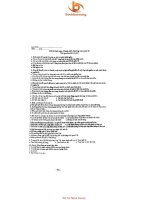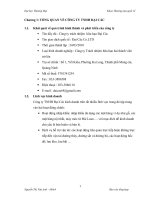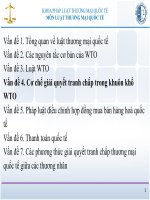Slide Thương mại quốc tế đại cương English ver
Bạn đang xem bản rút gọn của tài liệu. Xem và tải ngay bản đầy đủ của tài liệu tại đây (3.46 MB, 176 trang )
<span class="text_page_counter">Trang 1</span><div class="page_container" data-page="1">
<b>Introduction to </b>
<b>International Trade and Finance</b>
FACULTY OF INTERNATIONAL BUSINESS
<i><b>Lecturer: Nguyen Thu HuongMobile: 0947877111</b></i>
<i><b>Email: </b></i>
</div><span class="text_page_counter">Trang 2</span><div class="page_container" data-page="2"><i><b>Completed this subject, students will be able to:</b></i>
• Understand the key concepts and terminologies in international trade
• Understand the forces in international trade environment • Understand the roles and responsibilities of all parties
involved in international trade and finance
• Understand the process involved in international trade and sources of laws and convention applicable to such process • Understand and select the appropriate methods of
international payment
• Understand the current banking practices and forms of international trade finance
<b>• Take a Certificate of International Trade and Finance(CITF)</b>
</div><span class="text_page_counter">Trang 3</span><div class="page_container" data-page="3">Course overview
Topic 1: Introduction
Topic 2: The international trade environment
Topic 3: Contracts and documents
Topic 4: Methods of payment
Topic 5: Trade Finance Management
</div><span class="text_page_counter">Trang 5</span><div class="page_container" data-page="5">Course Assessment
• Class attendance: 10%
• 01 Case study (covering topic 1, 2, 3): 15% • 01 Mid-term test: (covering topic 4): 15% • Final exam: 60%
</div><span class="text_page_counter">Trang 6</span><div class="page_container" data-page="6">Case study
Select a Vietnamese company which have already involved in exporting. Imagine that you are a trade consultant who needs to suggest a new country market for the company to make an entry. Write a report which covering the following contents:
- Introduction
- Company background
- Reasons for finding a new foreign market
- Select a potential country market and do PESTEL analysis to support your choice
- Select a method of entry and explain your choice - Conclusion
Writing language: English Word limit: 3000 Deadline: TBC
</div><span class="text_page_counter">Trang 7</span><div class="page_container" data-page="7">• Finance of International trade - Eric Bishop (2004) • ICC publication: Incoterms 2010, UCP 600, ISBP 745
• UN Convention on Contracts for the International Sale of Goods (CISG)
</div><span class="text_page_counter">Trang 8</span><div class="page_container" data-page="8">Student’s Responsibilities
• Attend class regularly
• At home: Read and prepare answers for questions of the next class
• In class: take notes and submit answer sheets on group basis • Work in groups for homework, in-class discussion and case
studies
• Raise your voice if you have any ideas or questions related to the lecturers
</div><span class="text_page_counter">Trang 9</span><div class="page_container" data-page="9">Topic 1: Introduction
1. The concept of International Trade
2. Risks and risk mitigants in international trade
3. Parties involved in international trade
</div><span class="text_page_counter">Trang 10</span><div class="page_container" data-page="10">1. The concept of International trade
International trade is the exchange of goods, services or
<i><b>performance and capital across international borders or territories </b></i>
</div><span class="text_page_counter">Trang 11</span><div class="page_container" data-page="11">Borders or Territories ???
<b>Border: a line separating two political or </b>
geographical areas, especially countries.
<b>Territory: an area of land under the jurisdiction </b>
of a ruler or state
</div><span class="text_page_counter">Trang 13</span><div class="page_container" data-page="13">Read the article on page 1, 2 & 5 and answer the question:
- What are motivations of international trade to Buyer/ Seller? - Who is the Buyer? Who is the Seller?
- What are the different names of Buyer/ Seller?
- When do we call Buyer/ Seller by its other names?
- Are the objects of international trade always things that can be seen?
</div><span class="text_page_counter">Trang 14</span><div class="page_container" data-page="14">Comparative advantage
Table 1.1: Using Ricardo’s theory of comparative advantage:
</div><span class="text_page_counter">Trang 15</span><div class="page_container" data-page="15">Total output produced 2 litres of
wine <sup>4 rolls of </sup>cloth Net output after exchange
of 2 rolls of cloth by England for 1 litre of wine from Net gain from comparative
advantage <sup>1 roll of cloth 1 roll of cloth </sup>
</div><span class="text_page_counter">Trang 16</span><div class="page_container" data-page="16">2. Risks and Risk Mitigants
<b>Discussion: </b>
<b>Whether international trading is more difficult and risky than </b>
domestic one? Why?
<b>Hints: See page 9, 10, 22, 23, 24</b>
</div><span class="text_page_counter">Trang 17</span><div class="page_container" data-page="17">2. Risks and Risk Mitigants
</div><span class="text_page_counter">Trang 18</span><div class="page_container" data-page="18">2.1. Risks involved in international trade
<b>How do the following types of risk create adverse effects to the Buyer/ Seller?</b>
• Transport risk/ Transportation risk/ Risk of transporting • Fraud or risks related to financial crime
</div><span class="text_page_counter">Trang 19</span><div class="page_container" data-page="19">2.2. Risk mitigants
<b>Read the articles on page 10 & 11 and explain how the following organizations can help reduce risks involved in international trade:</b>
• Local chambers of commerce
• Standard protocols and interpretations of legal issues
</div><span class="text_page_counter">Trang 20</span><div class="page_container" data-page="20">3. Parties involved in international trade
<b>Seller/ Exporter<sub>Buyer/ Importer</sub></b>
</div><span class="text_page_counter">Trang 21</span><div class="page_container" data-page="21">3.1. Business organization
A business involved in buying and selling goods and services with the aim of making profit
- Limited or Unlimited (What is limited/ unlimited? 🡪See page 6) - One owner or more than one owner
- Private or public (what is private/ public? See page 8 & page 9)
</div><span class="text_page_counter">Trang 23</span><div class="page_container" data-page="23">3.2. Freight forwarder
<b>Organizations that manage the movement of goods </b>
internationally using the appropriate mode of transport
<b>Discussion: What does the phrase “manage the movement of </b>
goods” mean?
<b>Hints: See page 61</b>
</div><span class="text_page_counter">Trang 24</span><div class="page_container" data-page="24">3.3. Insurance companies
- What to insure? - Why to insure?
- Who must buy insurance? The seller or the buyer? Phu thuoc vaof Incoterm
<b>Hints: See page 62</b>
</div><span class="text_page_counter">Trang 25</span><div class="page_container" data-page="25">3.2. The World Trade Organization
• Formed in 1995
• General Agreement on Tariffs and Trade (GATT) • 164 members
<b>The WTO provides a forum for negotiating agreements aimed at reducing obstacles to international trade and ensuring a level playing field for all, thus contributing to economic growth and development. The WTO also provides a legal and institutional framework for the implementation and monitoring of these agreements, as well as for settling disputes arising from their interpretation and application. </b>
Hongkong: Khu tự trị
</div><span class="text_page_counter">Trang 26</span><div class="page_container" data-page="26">3.2. The World Trade Organization
Watch a video about WTO and take notes as much as you can
</div><span class="text_page_counter">Trang 27</span><div class="page_container" data-page="27">3.3. The International Chamber of Commerce
• Publications: Incoterms, UCP, ISBP
Watch a video about ICC and take notes as much as you can
</div><span class="text_page_counter">Trang 28</span><div class="page_container" data-page="28">Topic 2: International Trade Environment
1. External factors affecting international trade
2. Marketing research before a foreign entry
3. Methods of entering an overseas market
</div><span class="text_page_counter">Trang 29</span><div class="page_container" data-page="29"><b>1. External factors affecting international trade</b>
<b>What are the above factors called in Vietnamese?</b>
</div><span class="text_page_counter">Trang 30</span><div class="page_container" data-page="30"><b>Case study: Imagine that you are managers of a Vietnamese </b>
seafood company which wants to export to German market. What should you include in your PESTEL analysis?
<b>Hints: See page 20 & 21</b>
<b>1. External factors affecting international trade</b>
</div><span class="text_page_counter">Trang 31</span><div class="page_container" data-page="31">2. Marketing research
to research???
</div><span class="text_page_counter">Trang 33</span><div class="page_container" data-page="33">Credit reference agencies Credit ranking agencies Credit Insurers
The Internet and the media Networking
Self-check
</div><span class="text_page_counter">Trang 34</span><div class="page_container" data-page="34">3. Methods of entering an overseas market
The company must decide whether market factors </div><span class="text_page_counter">Trang 35</span><div class="page_container" data-page="35">3.1. Manufacture “at home”
• Sell direct to the foreign end users
• Engage the services of an intermediary that specializes in finding foreign markets and buyers
Indirect Exporting
<b>Vocabulary check</b>
What are the differences among:
A. Export B. Exporting C. Exportation
</div><span class="text_page_counter">Trang 36</span><div class="page_container" data-page="36">1. What are the advantages/disadvantages of direct exporting ? 2. What are the advantages/disadvantages of indirect exporting? 3. When should a company adopt direct exporting/indirect
<b>Case study:</b>
Watch a video and list the reasons that force Vietnamese seafood companies select indirect exporting instead of direct exporting.
<b>Hints: See page 30 & 31</b>
3.1. Manufacture “at home”
</div><span class="text_page_counter">Trang 37</span><div class="page_container" data-page="37">3.1.1. Direct exporting
SUMIMOTO is a company based in Japan specializing in auto parts. The company has built a manufacturing plant in Vietnam since 2015. Have SUMIMOTO adopted direct exporting ?
A. If SUMIMOTO has a subsidiary which has done business registration in Vietnam
B. If the manufacturing plant is within a special customs supervision area in Vietnam
</div><span class="text_page_counter">Trang 38</span><div class="page_container" data-page="38">3.1.2. Indirect exporting
• Agents
• Distributors • Co-marketing
</div><span class="text_page_counter">Trang 39</span><div class="page_container" data-page="39">3.1.2. Indirect exporting
Find and contact the foreign markets/ buyers
Employed by the principal on a
commission basis and retainer fee Take ownership of the goods
Assume higher risks
Purchase the goods outright and resell Set the price in overseas markets
Negotiate the sale on behalf of the principal
Negotiate the sale on behalf of itself Earn a profit
Provide after-sales support
See pages 32 & 33 and fill out the table
</div><span class="text_page_counter">Trang 41</span><div class="page_container" data-page="41">3.1.2. Indirect exporting
Export management companies Export trading houses
Confirming houses Buying agents
<b>Discussion: The following intermediaries are agents or distributors?Hints: See page 31 & 32</b>
</div><span class="text_page_counter">Trang 43</span><div class="page_container" data-page="43">3.1.2. Indirect exporting
List advantages and disadvantages of indirect exporting
<b>Hints: See page 31</b>
</div><span class="text_page_counter">Trang 45</span><div class="page_container" data-page="45">A Finnish firm, a German firm and a Brazilian firm create a joint venture in Vietnam
German Firm
Brazilian Firm
</div><span class="text_page_counter">Trang 46</span><div class="page_container" data-page="46"><small>An Italian firm creates a joint venture with a Vietnamese </small>
<small>partner to enter the Vietnamese market</small>
Vietnamese Firm
</div><span class="text_page_counter">Trang 47</span><div class="page_container" data-page="47">3.2.1. Joint Venture
List advantages and disadvantages of Joint Venture
<b>Hints: See page 34</b>
</div><span class="text_page_counter">Trang 48</span><div class="page_container" data-page="48">1. Who is the licensee/ licensor ?
2. What do the intellectual property rights include?
3. What are advantages/ disadvantages of international licensing ?
</div><span class="text_page_counter">Trang 49</span><div class="page_container" data-page="49"><i><small>Intellectual Property Rights, Training, Business Advice, Marketing assistance, etc.</small></i>
</div><span class="text_page_counter">Trang 50</span><div class="page_container" data-page="50">3.2.3. International Franchising
1. What do the intellectual property rights include?
2. What are advantages/ disadvantages of international franchising?
3. What are differences between franchising and licensing?
<b>Hints: See page 35 & 36</b>
</div><span class="text_page_counter">Trang 51</span><div class="page_container" data-page="51">3.2.3. International Franchising
</div><span class="text_page_counter">Trang 52</span><div class="page_container" data-page="52">Topic 3: Contract and Documents
1. The ordering process
2. The contract and contract management 3. UN Convention on CISG
4. Incoterms 2010 rules
5.Dispute handling and arbitration
6. Documents used in international trade
</div><span class="text_page_counter">Trang 53</span><div class="page_container" data-page="53">1. The ordering process
Arrange the following tasks according to the ordering process and specify who will do in each step:
<b>A. Make an enquiry</b>
<b>B. Arrange for shipment of the goods</b>
<b>C. Consider the enquiry and make modifications if any</b>
<b>D. Ship the goods</b>
<b>E. Receive the goods and </b>
</div><span class="text_page_counter">Trang 55</span><div class="page_container" data-page="55">1. The ordering process
</div><span class="text_page_counter">Trang 56</span><div class="page_container" data-page="56">2. The contract and contract management
<b>2.1. Definition of “Contract”</b>
<b>An agreement between two or more persons or entities, which may or may not contain specific terms, in which there is a promise to do something in return for a consideration </b>
</div><span class="text_page_counter">Trang 57</span><div class="page_container" data-page="57">• A firm offer + An acceptance of a firm offer • An intention to create a contract
• Consideration
• Capacity to contract • Consent
• Legal purpose
<b>2.2. Conditions for a valid contract to come into effect</b>
</div><span class="text_page_counter">Trang 58</span><div class="page_container" data-page="58"><b>2.2. Conditions for a valid contract to come into effect</b>
Seller X send a firm offer to Buyer Y. Which reactions of Y will form a contract:
A. Give entire acceptance
B. Give acceptance but with reservations or conditions C. Reject the offer entirely
<b>Hints: See page 42 & 43</b>
</div><span class="text_page_counter">Trang 59</span><div class="page_container" data-page="59"><b>2.3. Usual terms of a contract</b>
See page 43 and guess what information should be included in each term of a contract as belows:
</div><span class="text_page_counter">Trang 60</span><div class="page_container" data-page="60">Prepare export documentation Decide method of settlement Fulfill the contract
Manage contract processing and check progress
</div><span class="text_page_counter">Trang 61</span><div class="page_container" data-page="61"><b>2.5. Sources of laws governing the contract</b>
<b>3.1. Convention or agreements among/ between countries </b>
<b>3.2. Laws of a specific country</b>
<b>3.3. International practices and customs </b>
</div><span class="text_page_counter">Trang 62</span><div class="page_container" data-page="62"><b>3. UN Convention on Contracts for the International Sale of Goods (CISG)</b>
<b>Read the article on page 46 & 47 and answer the question:</b>
1. What is the CISG about?
2. Who did develop the CISG? When? 3. When did the CISG come into effect?
4. How many countries have ratified the CISG? 5. Who will use the CISG?
6. What are benefits of the CISG?
</div><span class="text_page_counter">Trang 63</span><div class="page_container" data-page="63"><b>3. UN Convention on Contracts for the International Sale of Goods (CISG)</b>
<b>Content of the CISG:</b>
• Sphere of application and
</div><span class="text_page_counter">Trang 64</span><div class="page_container" data-page="64"><b>3. UN Convention on Contracts for the International Sale of Goods (CISG)</b>
- What are the downside of the CISG?
- If Vietnam has joined the CISG? We do not need pass through any laws and regulations about contract?
<b>Hints: See page 49</b>
</div><span class="text_page_counter">Trang 65</span><div class="page_container" data-page="65">4. International Commercial Terms (Incoterms)
<b>See page 91 and answer the question:</b>
- What are Incoterms about?
- What are the benefits of using Incoterms?
- What are “Shipping terms” and “terms of delivery” about?
</div><span class="text_page_counter">Trang 69</span><div class="page_container" data-page="69"><b><small>Allocations of costs buyer/seller according to Incoterms 2010</small></b>
<b><small>EXW</small></b> <small>BuyerBuyerBuyerBuyerBuyerBuyerBuyerBuyerBuyerBuyerBuyer</small>
<b><small>FCA</small></b> <small>SellerSellerBuyerBuyerBuyerBuyerBuyerBuyerBuyer Buyer Buyer</small>
<b><small>Sea only)</small></b> <small>SellerSellerSellerSellerSellerSellerSellerBuyerBuyerBuyerBuyer</small>
<b><small>CPT</small></b> <small>SellerSellerSellerSellerSellerSellerBuyerSellerSellerBuyerBuyer</small>
<b><small>CIP</small></b> <small>SellerSellerSellerSellerSellerSellerSellerSellerSellerBuyerBuyer</small>
<b><small>DAT</small></b> <small>SellerSellerSellerSellerSellerSellerSellerBuyerBuyerBuyerBuyer</small>
<b><small>DAP</small></b> <small>SellerSellerSellerSellerSellerSellerSellerSellerSellerBuyerBuyer</small>
<b><small>DDP</small></b> <small>SellerSellerSellerSellerSellerSellerSellerSellerSellerSellerSeller</small>
</div><span class="text_page_counter">Trang 70</span><div class="page_container" data-page="70">4. International Commercial Terms (Incoterms)
Where is the risk transferred from the buyer to the seller?
How is the cost allocated between the buyer and the seller?
What are obligations of the buyer and the seller?
</div><span class="text_page_counter">Trang 71</span><div class="page_container" data-page="71">4. International Commercial Terms (Incoterms)
<b><small>A. THE SELLER’S OBLIGATIONSB. THE BUYER’S OBLIGATIONS</small></b>
<small>A1. General obligations of the sellerB1. General obligations of the buyerA2. Licences, authorizations, security </small>
<small>clearances and other formalities</small>
<small>B2. Licences, authorizations, security clearances and other formalities</small>
<small>A3. Contracts of carriage and insuranceB3. Contracts of carriage and insuranceA4. DeliveryB4. Taking delivery</small>
<b><small>A5. Transfer of risksB5. Transfer of risksA6. Allocation of costsB6. Allocation of costs</small></b>
<small>A7. Notices to the buyerB7. Notices to the sellerA8. Delivery documentB8. Proof of deliveryA9. Checking – packaging – markingB9. Inspection of goodsA10. Assistance with information and </small>
<small>related costs</small> <sup>B10. Assistance with information and </sup><small>related costs</small>
</div><span class="text_page_counter">Trang 72</span><div class="page_container" data-page="72">5. Dispute handling and arbitration
<b>Three basic means of resolving a dispute:</b>
- Reaching a mutually satisfactory compromise - Arbitration
- Presenting to courts
<i>See page 50 and list the advantages and disadvantages of each method above</i>
</div><span class="text_page_counter">Trang 73</span><div class="page_container" data-page="73">What are documents used in international trade? Why do need them?
</div><span class="text_page_counter">Trang 74</span><div class="page_container" data-page="74">6. Documents used in international
</div><span class="text_page_counter">Trang 75</span><div class="page_container" data-page="75">How many kinds of financial documents can you think of?
</div><span class="text_page_counter">Trang 76</span><div class="page_container" data-page="76">6.1. Financial documents
• Bill of Exchange• Promissory Note
</div><span class="text_page_counter">Trang 77</span><div class="page_container" data-page="77">2. By which law Bill of exchange is governed?
3. How many parties involved in a Bill of exchange transaction?
4. What are the characteristics of a Bill of exchange?5. How many types of Bill of exchange?
</div><span class="text_page_counter">Trang 78</span><div class="page_container" data-page="78">6.1.1. Bill of exchange
According to the UK Bills of Exchange Act 1882:
<i>“A bill of exchange is an unconditional order in writing, addressed by one person to another, signed by the person giving it, requiring the person to whom it is addressed to pay on demand or at a fixed or determinable future time a sum certain in money to or to the order of a specified person or to bearer”</i>
</div><span class="text_page_counter">Trang 79</span><div class="page_container" data-page="79">6.1.1. Bill of exchange
<b>Sample 1:</b>
<b>Bill of exchange(1)</b>
No123a.b(2) (4)Ha noi, 27, Sep, 2008(5) For 1400US dollars(3)
<b>(6)At sight of this first Bill of exchange (second of the same tenor and date being unpaid) pay to the order of MrX(7) </b>
the sum of (3)American United State one thousand four hundred.
(8)To MITSUMI.comp (10) TOCONTAP. comp (9) Japan Signed
</div><span class="text_page_counter">Trang 80</span><div class="page_container" data-page="80">Which of the following payment time is considered as “determinable future time”?
<i>1. 90 days after B/L’s date2. 90 days after invoice date</i>
<i>3. 90 days after the arrival of the ship4. 90 days after sight</i>
<i>5. 90 days after date </i>
<i>6. 90 days after date sight</i>
</div><span class="text_page_counter">Trang 81</span><div class="page_container" data-page="81">6.1.1. Bill of exchange
<b>Sample 2: Explain the meaning of notes from (1) to (10)</b>
Bill of exchange(1)
No123a.b(2) (4)Ha noi, 27, Sep, 2008(5) For 1400US dollars(3)
<b>(6)At D/A 60 days after date sight of this first Bill of exchange (second of the same tenor and date being unpaid) pay to </b>
the order of …. the sum of (3)American United State one thousand four hundred.
(8)To MITSUMI.comp (10) TOCONTAP. comp (9) Japan Signed
</div>








